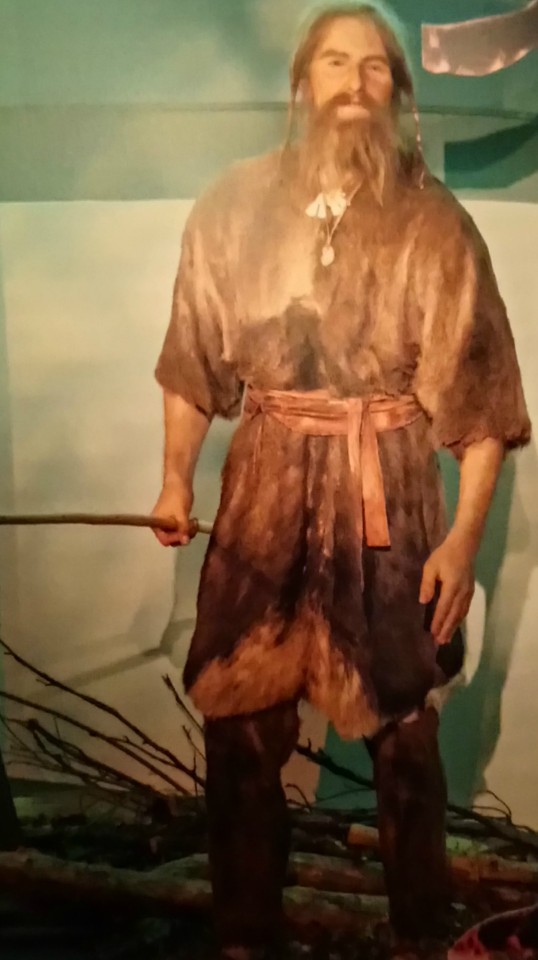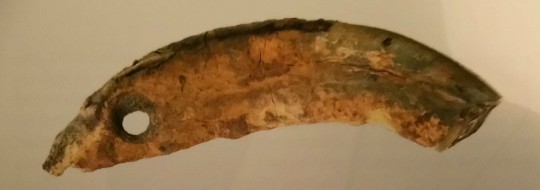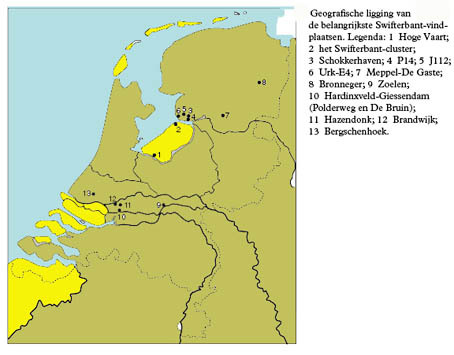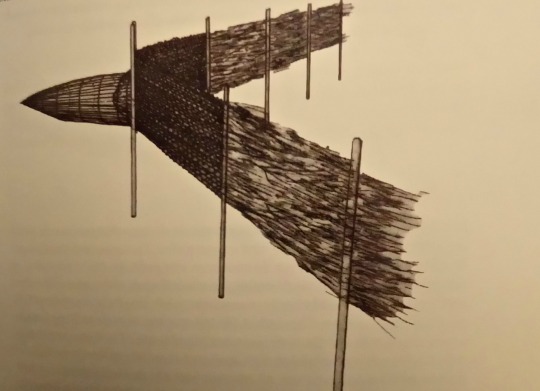#Swifterbant
Explore tagged Tumblr posts
Text
"Archaeologists have discovered evidence for the earliest cattle herds in northern Europe, at the site of Swifterbant in the Netherlands. Using a combination of zoological, botanical, and biochemical methods, they investigated the emergence of farming in northern Europe and found that, not only are these the earliest known domestic cattle, they were also managed in very specific ways.
Agriculture spread through central Europe around 7,000 years ago with the migration of the people of the Linear Pottery culture. North of this region, however, the indigenous inhabitants of what are now the Netherlands, northern Germany, Scandinavia, and Britain continued to live as hunter-gatherers; how and when they adopted farming remains a matter of much debate.
The timing and character of the start of animal husbandry in the Dutch part of this region was studied in a project based at the University of Groningen. The results are published in the journal Antiquity."
"By looking at the diet of the cattle, they found that these animals could be separated into two different groups based on what they ate. One herd had grazed in forests, while the other had been pastured either on manured fields or in the salt marshes.
This also challenges how we view early farmers.
"These results tell us that not only were there already farmers in this region as early as 4240 BC, they were managing their livestock in complex ways, either using distinctive grazing strategies or acquiring certain stock from elsewhere," says Dr. Brusgaard. "These early farmers were incredibly knowledgeable about how to manage livestock in this dynamic environment.""
continue reading article
#archaeology#history#farming#culture#europe#northern europe#cattle#herds#domestic cattle#farming history#the netherlands#swifterbant#livestock#food#society#agriculture#environment#animals#humanity
0 notes
Text

Wreck of a Dutch Ventjager, a more than 300-year-old fishing vessel from the bottom of Flevoland.
The 14 metre long wreck was excavated near Swifterbant in 1986 and completely salvaged, as were the many finds inside. As the wreck was lying at an angle on the bottom, the starboard side is largely rotten, which provides an extraordinary insight into the internal structure of the ship.
162 notes
·
View notes
Text
Pagan/Occult timeline on this Tumblr
(with some accents on Frisia/Holland/the Netherlands)
Stone Age
Palaeolithic . Rock art
Mesolithic . Swifterbant Culture (in the NL ca. 5300-3400 BCE)
Neolithic . Vlaardinger Cultuur (in the NL ca. 3500-2500 BCE) . Trechterbekervolk (= Funnel Beaker Culture, in the NL ca. 3350-2750 BCE ) and their Hunebed (dolmen) Ancestor worship may have existed in the Neolithic. Some scholars suggest a direct link between Palaeolithic female ('venus') figurines and female depictions in the Neolithic and even Bronze Age. In the Copper Age, male deities were also worshipped, and there was a development towards forming a complete pantheon with mythological figures. Domestication of plants and animals is in its formative stages here, and 'Industry' comes up, mainly of utensils and ornaments. The invention of writing started here, between copper and bronze age. Invention of the wheel. Invention of the potter's wheel.
Bronze Age
Hallstatt Culture (roughly 1200-450 BCE)
Northern Bronze age (roughly 2000-500 BCE)
2000 BCE
17th century BCE
15th century BCE
13th century BCE
11th century BCE
10th century BCE
8th century BCE . Oldest findings of Frisian pottery
7th century BCE
6th century BCE
Northern Iron age (roughly 500 BCE - 800 CE)
5th century BCE
4th century BCE
3rd century BCE
2nd century BCE
1st century BCE
1st century . Oldest known runic inscription
2nd century
3rd century
4th century . Big migration of North German and Danish tribes into East and Central (=North of the NL) Frisia, and expansion of West Frisia
5th century . Oldest known runic inscription mentioning Oðinn . Big migration of North German and Danish tribes into East and Central Frisia and expansion of West Frisia . Rise of the Merovingian dynasty among the Franks
6th century . Frisia is at its peak and now covers the Dutch entire North + West coastal region, river area, and North coast of Germany . Merovingian dynasty at the Franks - expansion
7th century . Transition younger futhark. . Merovingian dynasty at the Franks - expansion
8th century . Transition younger futhark . Merovingians (Franks) incorporate Frisia. Put a lot of effort into converting forcing the local tribes in Europe to Christianity
Viking age (roughly 800-1100 CE)
9th century . In now Frankish 'Frisia', the name Holtland appears
10th century . Estimated writing of the Vǫluspǫ́.
11th century
12th century . Floris II no longer calls himself Frisian, but Count of Holland . Earliest known Western heraldic
The last bits of the Medieval age
13th century . Estimated start of development of Christian "Kabbalah"
14th century
15th century . Giovanni Pico della Mirandola (humanist, Hebrew studies) . Johann Reuchlin (humanist, Hebrew studies, developer of the angel names) . Heinrich Cornelius Agrippa (occultist, developer of the demon-scales)
Modern History
16th century . Giordano Bruno . Edward Kelley (also known as Edward Talbot) . John Dee (occultist, developer of Enochian magic) . Sir Francis Drake's drum
17th century . Dutch Streekdracht Folklore estimated start
Athanasius Kircher (developer of the Tree of Life as used in Hermetic Kabbalah) . Rosicrucianism . The Lesser Key of Solomon
18th century
Dutch Streekdracht Folklore peaks
19th century
Dutch Streekdracht Folklore peaks . Éliphas Lévi, real name Alphonse Louis Constant (occultist, writer of Dogme et Rituel de la Haute Magie and initiator of the Kabbalistic Cross) . Helena Blavatsky (occultist, founder of the Theosophical Society and famous for her Atlantis work) . Samuel MacGregor Mathers & William Westcott (founders of the Hermetic Order of the Golden Dawn) . Arthur Edward Waite (occultist, GD member, laid down the foundations for nearly all contemporary tarot decks)
20th/21st century
Dutch Streekdracht Folklore decline . Dion Fortune (occultist) . Israel Regardie (occultist) . Gerald Gardner (founder of Gardnerian Wicca) . Doreen Valiente (co-founder of Gardnerian Wicca) . Gareth Knight (occultist) . Walter Ernest Butler (occultist) . Dolores Ashcroft-Nowicki (occultist) . Alex Sanders (founder of Alexandrian Wicca) . Diana L. Paxson (Witch, Wicca, Asatru) . Marian Green (Solitary Witch) . Vivianne Crowley (Wicca) . Frigga Asraaf (NL Asatru) . Linda Wormhoudt (NL Shaman)
4 notes
·
View notes
Photo





Swifterbant Culture
The Swifterbant culture is a prehistoric culture that developed around modern day Flevoland, the Netherlands. Traces of this culture have also been found more to the south and in Germany. Swifterbant people lived between 5000BC-3400BC and they are fascinating because these people were hunter and gatherers who developed agricultural skills. Proof that the second wave of migration into Europe, people who were farmers, from around 7000BC, did not just replace the hunter gatherers. Agriculture developed on its own as well.
This prehistoric culture was discovered by J.J Aukema in 1962. Flevond was still being created, barely 30 years earlier the Afsluitdijk was build, turning the Zuiderzee into a big lake. After the first pieces of pottery and flint arrowheads were discovered by Aukema, A large archeological research was conducted in the area during the 1970's. Several settlements were discovered from people who used to live here 7,000 years ago.
It is hard to imagine how modern day Flevoland used to be a rich landscape with dunes, swamps, forests and creeks. This rich landscape turned into a lake called the Flevomeer around 500BC before turning into a sea called the Zuiderzee. This sea existed until 1932 when the Afsluitdijk was build, turning the sea into a lake once more. A large part of the lake was drained and thus the modern province of Flevoland was created.
In total, 14 Swifterbant settlements have been discovered in Flevoland during the draining of the land. Only two of these settlements have been dug up, the other 12 have been carefully researched without disturbing the land. The Swifterbant people were originally hunter and gatherers who enjoyed the rich flora and fauna. The area was lush and filled with all kinds of wildlife, perfect for a stone age hunter and gatherer culture. Raising sea levels however slowly started to change the landscape and the ground was getting wetter and wetter. The lush forests with its creeks disappeared and changed into swamps.
This change in landscape could have been the reason why these prehistoric people started to experiment with agriculture. The rich fauna disappeared thus so did most of their food supply. They were forced to either move to a new area or try to cultivate their own food.
This Swifterbant culture is almost exactly similar to the Scandinavian Ertebølleculture. Both cultures developed around the same time, 5600BC. They are in fact so similar that it is almost impossible to see cultural differences. The biggest difference is that the Swifterbant culture started to keep cattle thousand years before the Ertebølle culture did. The Swifterbant culture and the Ertebølleculture developed into the Funnelbeaker culture around 4300BC.
I have written a post about this culture back in September for those who are curious. One of the most interesting finds of this culture was discovered in 2018. The remains of a young woman with a baby in her arms. This baby is the oldest baby ever found in the Netherlands. DNA research confirmed that the woman was the mother of the baby and the baby was a female.
Now for those people who are curious about the meat diet of a mesolithic hunter and gatherer human, here is a list of animals used/eaten by the Swifterbant people. You can see that their diet was quite varied, this is thanks to the rich fauna that lived in the area and the lush landscape. Of course fruits and vegetables were eaten as well.
Pets: Pig, cattle, sheep, goats and dogs
Hunted animals:Wild boar, Beaver, Red Deer, Otter, Elk, Roe deer, Badgers, Wild Cat, Fox, Polecat, Weasel, Mole, Brown Bear, Auroch, Horse, Sea Lion.
Fish:Garfish, Catfish, Bream, Roach, Tench, Sea Bass, Sturgeon, Eel, Salmon
Birds:Wild Duck, Geese, Swan, Crow, Jay, Sea Eagle, Crane, Seagull, Cormorant, Grebe.
Here are photos of: Swifterbant male reconstruction, Swifterbant female and baby skeleton, Swifterbant Farm, Swifterbant tools, pottery and jewelry, A map that shows Swifterbant finds
86 notes
·
View notes
Photo

With one of my besties Laetitia @letizia.christina at our Circuit Assembly in Swifterbant last. She's the queen of photos but I always have to laugh and make silly faces. That's the result...🤣🤪😜😝 • • • #zgromadzenieobwodowe #przyjaciolki #polacywholandii #polkawholandii #jwholandia #jwpolska #jwpoland #jwholland #jwnetherlands #kringvergadering #jwgirlfriends #jwfriendsthenetherlands #swifterbant (bij Congreshal Swifterbant) https://www.instagram.com/p/B-nDFU0DAHr/?igshid=jg9ez0xqw402
#zgromadzenieobwodowe#przyjaciolki#polacywholandii#polkawholandii#jwholandia#jwpolska#jwpoland#jwholland#jwnetherlands#kringvergadering#jwgirlfriends#jwfriendsthenetherlands#swifterbant
0 notes
Photo

En nog eentje vh #koekjesbakken Zo gezellig!!! ⭐🐊🦒🦔🦇🍪🥤🎄 #koekjesdeeg #koek #zandkoekjes #boter #bloem #suiker #eidooier #vanilleextract #zout #feestdagen #ei #kerstvakantie #oudennieuw #nieuwjaar #luca #lisa #lifeofamom #lekker #leuk (bij Swifterbant) https://www.instagram.com/p/B6nz7xghocZmQcV_0h4jUtqwldUTNowR_Im0XI0/?igshid=b4ej4if752px
#koekjesbakken#koekjesdeeg#koek#zandkoekjes#boter#bloem#suiker#eidooier#vanilleextract#zout#feestdagen#ei#kerstvakantie#oudennieuw#nieuwjaar#luca#lisa#lifeofamom#lekker#leuk
1 note
·
View note
Photo

“Love is not just looking at each other, it’s looking in the same direction.” — Antoine de Saint-Exupery #celebratinglove #netherlands #love #myforevertravelbuddy #JLjourney (at Swifterbant) https://www.instagram.com/p/Bxf7qRPiXdkm5Fs8VqVrsW3JcfJ41FOE93U33E0/?igshid=12hwl4uj6k3dg
1 note
·
View note
Text
De Ventjager
On 18 September 1986, a crane operator found a shipwreck while digging a canal in Swifterbant, Netherlands. Since the site was a construction site, only three weeks were available for the excavation of the ship. During the emergency excavation, the ship was dug out and only the location of the objects in the ship's inventory was surveyed.

The wreck with a length of 14.5 m, a width of 4 m and a draught of 1 m was found with an unusually large interior space of about 5.7 m length, more than half of which has been preserved. This large interior and part of the cargo indicated that this ship was once a live fish transporter.

The oven and the three cambers
In the aft a complete oven were found.Near it a considerable number of objects were found, which were probably used for cooking, frying and roasting fish.

The artifacts which were found can be dated very well, as they included two calibrated weights from 1658 and 1667, a bearded jug dated 1688 and especially some staves dated 1695, and suggest that the ship probably sank around 1700.

The Amsterdam coat of arms, three crosses on the four tin spoons and a wooden bowl indicate that Amsterdam may have been the ship's home port or the market place for selling fish.

The now preserved wreck in the exhibition
Given to the good condition of the hull, it was decided to lift the ship into three parts and transfer it to the workshops of the then Museum of Naval Archaeology in Ketelhaven for further documentation. After the documentation, the parts of the ship were assembled and provided with a support, after which the ship was preserved in an air-conditioned room. In 2006, the ship was restored and then taken to Nieuw Land for the exhibition, where the ship was set up in 2009.
220 notes
·
View notes
Video
youtube
Swifterbant culture, hunter gatherers in what is now called the province of Flevoland. Interesting archeological finding, that the clan leader was buried wearing a "crown" of amber stones. And of course the aurochs ‘worship’.
#swifterbant#flevoland#stone age#neolithic#video#netherlands#amber#bovine#bovine worship#crown#palaeolithic#mesolithic
5 notes
·
View notes
Photo

AMBACHT PUUR AMBACHT 🛠️ @blonk.hydrauliek #Ambacht #Hydro #NikonNL #Swifterbant . . . . . #HypeBeast #vscoportrait #ig_mood #discoverportrait #portraitphotography #profile_vision #bleachmyfilm #postmoreportraits #portraitpage #igpodium_portraits #portraiture #makeportraits #ftwotw #makeportraitsnotwar #quietthechaos #makeportraitsmag #expofilm #nikonphotography #nikontop #nikon_photography_ #focalmarked — view on Instagram https://ift.tt/2sxH9Ej
0 notes
Photo





Swifterbant Fishing
Between 1999 and 2001, the remains of at least 10 fish barriers and 40 fish traps have been found in modern day Flevoland, the Netherlands dated back to around 3000BC which belonged to the Swifterbant culture, about which I wrote a post earlier this week. This fishing gear has been conserved very well. Perhaps because Flevoland was first land, then a lake, then sea and now land again.
The fish barriers in particular are special because they show that these people were very skilled at fishing thousands of years ago. They didn't simply use a spear or a rod to catch a fish, they made complicated traps in order to lure and trap fish.
The barriers are around 15 to 30 meters long and were shaped like a funnel. Fish could swim into the barrier but they couldn't get out again. The fish traps were made from willow branches and the poles supporting the barriers were made from birch, elm and hazel wood. The willow branches were woven and bound with a rope made from bark.
Several long, 2 meters long, taxus wood sticks have been found as well which were most likely used to keep the traps in place. This highly efficient way of fishing probably led to a surplus of fish for these mesolithic people. This makes archeologists wonder if they just caught fish for their own consumption or did they also catch it to use for trade?
Were they able to smoke the fish and transport it to other settlements for trade? Evidence for the use of small ships like canoes have been discovered as well near these Swifterbant settlements like peddles. Unfortunately direct evidence of trading this fish is gone by now but it might be very much so possible that these prehistoric people not just caught fish for food but for trade as well, which is a rare thing to see in mesolithic societies.
The way how these Swifterbant people used these fish barriers to fish has not changed for over 5000 years. Fishers in the Netherlands still use this exact same method until this day. It's a nice prehistoric tradition that still exists today so I thought it would be interesting to share.
Here are photos of: Swifterbant fish barrier found, Swifterbant fish traps, Reconstruction of the fish barrier, Modern day Dutch fish barrier, Canoe peddle found,
65 notes
·
View notes
Video
instagram
Today after the assembly in #swifterbant 😂🤣 Dziś po zgromadzeniu w #swifterbant 😂🤣 • • • • • • #swifterbant #kids #children #assembly #jwnetherlands #jw #jwkids #kingvergadering #kringvergaderinginswifterbant
#jwkids#jw#children#kids#assembly#kringvergaderinginswifterbant#jwnetherlands#kingvergadering#swifterbant
0 notes
Text
Co-Evolution of the Willow (Genus Salix) and Humankind with Particular Emphasis on Estuarine and Delta Systems- Juniper Publishers

Introduction
The willow (genus Salix) thrived in the floodplain environment since the upper cretaceous period, e.g. fruiting Salix catkins were found in the Pipe Creek Valley, Dakota (Figure 1). The life history of Salicaceae is closely related to riverine habitats. Therefore, characteristic traits have evolved. Efficient seed production is followed by establishment on exposed riverine sediments and fast growth. High bending capacity and breaking resistance make Salix shrubs and trees resilient to river currents and waves [1], erosion and sedimentation processes [2]. Moreover, plant parts resprout vigorously after fragmentation by physical disturbance and flooding [3].
Ancient civilisations developed settlements along major flows. Willows naturally occurring in floodplains were used for dwellings along the Euphrates more than 10.000 years ago and for construction, tool handles, hoes and ploughs during the dynasty of Ur in Mesopotamia [4]. Willows provided flexible twigs and branches for furniture, fences for shelter, and fish traps. Willow baskets for food, supply and for storage may have been among the first articles manufactured by human hunter-gatherer communities [5]. The Food and Agriculture Organization of the United Nations FAO [4] highlights willows as “Trees for Society and the Environment” serving humankind since the dawn of history.
Global Distribution
Salix is a globally distributed species rich genus that can be divided into two ecological groups, (i) non-alluvial species of forest, rocks, wetlands with stagnant water and prostrate shrubs of tundra and alpine habitats, and (ii) narrow-leaved alluvial tree and large shrub species adapted to floodplains used for their flexible shoots [6]. The largest tree Salix species belong to the widely distributed and cultivated willows of the floodplain environment (Figure 2). The white willow (Salix alba L.) forms softwood floodplain forests throughout Europe up to North Africa, Asia Minor and western Asia, and is worldwide planted near human habitations and on riverbanks. The Black willow (Salix nigra M.) forms extended forest stands along large rivers in North America, whereas S. humboldtiana W. is the only Salix species native to South American floodplains [7]. Salix phylogeny is complex due to frequent interspecific hybridization. Hybridization accompanied by polyploidy likely played a major role in modern Salix species evolution in genetically variable populations in disturbed floodplains and in cultivation [1].
Estuarine and Delta Systems
In South America, S. humboldtiana settles on non-tidal sandy deposits up to where the lower Parana Delta propagates in the Rio de la Plata estuary. Estuarine islands have been subjected to land use change since decades and today willow-plantations cover extended tidal freshwater wetlands [8]. Tidal freshwater wetlands were occupied by humans since they developed in coastal plain estuaries during the last 6.000 years. Ports were established because these sheltered locations were the most inland point in the estuary that could be reached by ships and where river discharge prevents salt water intrusion, but flat topography allows tides to determine the geomorphology and hydrodynamics [9].
Along the US Atlantic coast, downstream located oligohaline marshes were transferred into tidal freshwater forested wetlands due to colonial land clearance 300-500 years ago shifting sediment into tidal wetlands, resulting in increased accretion. More recently, tidal freshwater forest declines due to tidal inundation and increasing salinity from sea level rise [10], e.g. in the Mississippi Delta where the Black willow forms extended forest stands. Similarly, S. humboldtiana may be substituted by some ten-thousand hectares of tidal forest plantations consisting of hybrid-willows (S. alba and S. babylonica L. (syn. S. matsudana Koidzumi) genotypes exist in the Rio de la Plata Delta. Salix babylonica grows originally in sandy river valley depression in arid-semiarid regions of China with pendulous branches. The weeping willow is one of the most widely used tree in horticultural and environmental application [7] eventually due to adaptation to changing water levels.
North Sea Region
In the North Sea Region, vast tidal freshwater wetlands containing willows still occur along the Scheldt, Belgium, the Weser and the Elbe, Germany, in De Biesbosch and along the Oude Maas in the Netherlands [11]. Most European TFW were utilized by humans for similar reasons as in North America due to the availability of water, nutrient-rich soils for agriculture and the abundance of fish, shellfish, mammals, and plants for food and shelter. However, humans may have also been negatively impacted by flooding and mosquito-borne diseases [9]. Willows extract large quantities of water due to high evapotranspiration rates (phreatophyte-type of vegetation), and from historical references it is reported that willow plantations in malaria affected areas were the most effective for drying up the earth and thus sheltered human settlements [12]. The pulverized bark of Salix alba is even said “its having the properties of the Peruvian bark” and similar effects on “the agues” [13]. The “Marsh-Fever” occurred in brackish coastal and estuarine areas in North-West Europe connected to the occupational history. These areas were exploited by Ertebolle and Swifterbant people since the 5th millennium BC. Subsequent sedentary communities utilized fertile marshes and estuarine forests for pasturage and agriculture. The coastal malaria vector Anopheles atroparvus found hibernation chances in human settlements, stagnant brackish water provided sites for breeding in oxbow lakes and health risks increased in embanked polders with high-days from 1500-1750 AC [14].
Severe storm surges damaged dikes during that time. This lead to dike reinforcement along the Elbe estuary whereas pollard willows were planted along the dike for protection against surge and ice-scour (Figure 3). The willow plantations led to sediment accretion and prepared the foreland for the use as meadows and pastures. In addition, willow rods were harvested, used for fascines and groynes, and since 1800 until 1950 an extended willow culture for basketry, furniture is reported for most of the Haseldorfer Marsch [15], one of Europe`s largest tidal freshwater wetlands. However, after a major flood in 1962 a new constructed dikeline lead to the loss of approximately 75% of the former TFW area in the Haseldorfer Marsch. De Biesbosch consisted of approximately 8,000 ha TFW but lost vast areas due to the construction of a storm surge barrier. However, still more than 1.500 ha TFW exist including bulrush (Bies = Dutch word for bulrush; Bosch = bush) at lower and willow forests and coppices at higher elevations [11]. Bulrush and willows enhance sediment deposition and floodplain landform construction controlling ecosystem changes in space and in time [2]. Thus, creation of vegetated tidal wetlands in suitable locations for ecosystem-based coastal defence is recently proposed as an economic and ecologic supplement to conventional engineering [16].
These findings suggest that the floodplain willow is not only key resource and develops floor for life but evolves valuable and characteristic traits due to human cultivation what leads to the call “Make me a willow cabin at your gate” to implement tidal willow forest plantation and restoration [3].
Acknowledgement
The author likes to thank the colleagues at Royal Netherlands Institute for Sea Research Yerseke, NL, for fruitful discussion on the topic and Matthias Michalczyk, Friedrich-Wilhelm University Bonn, Department of Geography, for valuable comments that helped to improve the manuscript. We further thank the editors for the invitation to contribute to the journal.
I further wish to thank my colleagues in the Department Wetland Sciences and Engineering at University of Maryland for inviting me as a guest scientist to study the Chesapeake Bay tidal wetlands and the Genus Salix in Maryland and Washington DC.
To know more about Journal of Archaeology and Anthropology: https://juniperpublishers.com/gjaa/index.php
To know more about our website click on Open access Journals publishers: Juniper Publishers
1 note
·
View note
Photo

read about how to #painting with an #iron at the @threadless #threadless #blog #What's the #Craziest #ArtStyle You've Ever #TriedOut? @fruityshapes Link: http://bit.ly/2shx8sH#encausticworkshop #encausticartwork #encausticworkshops #flevopolder #dronten #cadeautips #flevoland #lelystad #creatief #cadeautip #swifterbant #creative #vriendinnendag #teenytinyart #prairie #birds #trees #switzerland #giveaway #painting #oneofakind #originalart http://ift.tt/2rpkPqf
21 notes
·
View notes
Photo

Even lol met mijn gezin maken! 🥰🥰🥰🥰🥰🥰 (bij De Snit Swifterbant) https://www.instagram.com/p/B9KQSc0l_31/?igshid=1258wndbgotf8
0 notes
Photo

~ Follow me 💛 #netherlands #tulipfields #yellowtulips #inlove (at Swifterbant) https://www.instagram.com/p/Bxf8nYhCBNjl-hfRUKZBplCg-fuYFbpXdguiZM0/?igshid=dkf5vyfiig0f
0 notes